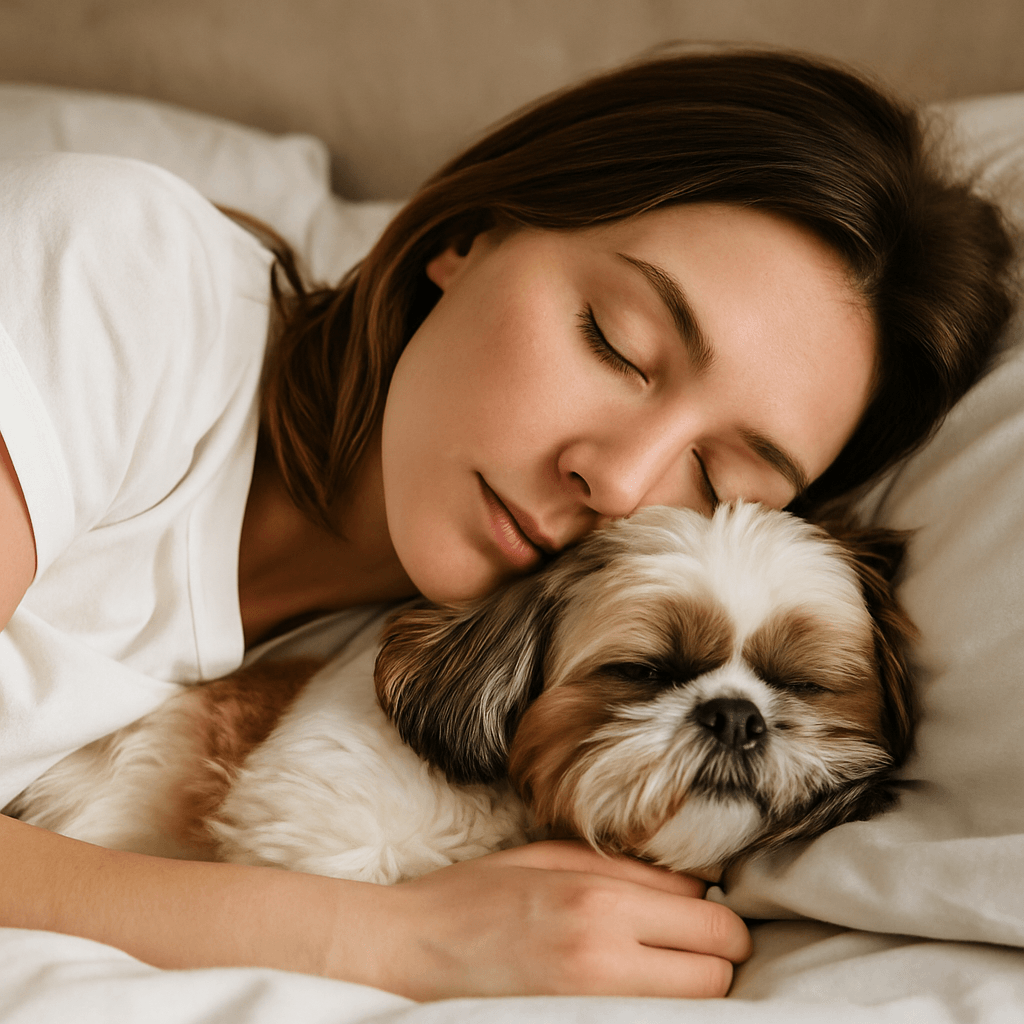
Can a dog sleep in bed with its owner? Facts, myths, and behavioral advice.
Contents
-
Why do dogs want to sleep with their owners?
-
Facts and myths – sleeping with your dog
-
Arguments for – what do you gain by sleeping with your dog?
-
Arguments against – potential threats and problems
-
The Voice of a Behaviorist – How Does It Affect a Dog's Psychology?
-
For whom is this a good solution and for whom is it not?
-
Alternatives – How to Create a Comfortable Sleeping Place for Your Dog
-
Frequently asked questions (FAQ)
-
Petto's recommended products
-
When to avoid sleeping with your dog? – Special situations
-
Summary
1. Why do dogs want to sleep with their owners?

For a dog, sleep isn't just about regeneration—it's also about emotional closeness. Dogs are social animals, and instinct drives them to sleep close to their "pack." In a home environment, that "pack" is you. The bed smells of your owner, provides a sense of security, and physical contact reduces stress and strengthens the bond.
From an ethological perspective, this behavior is completely natural. In wild packs, dogs sleep side by side, with their heads resting on family members to ensure mutual warmth and security. Translated into the home environment, this behavior remains unchanged—the dog seeks out its owner's body to feel calm and secure.
Additionally, physical contact stimulates the release of oxytocin, the so-called "bonding hormone," which has the same effect on dogs and humans as cuddling. That's why a dog snuggling up to you in the evening can calm your nerves after a long day.
Sleeping together can also be an expression of a strong emotional bond or... comfort. The bed is often the warmest, softest, and most fragrant place in the house, and dogs—like people—really enjoy comfort.
2. Facts and myths – co-sleeping with a dog
✅ Fact: Co-sleeping can reduce stress levels
Physical contact and peaceful sleep next to their owner have a calming effect on both humans and dogs. It has been proven that a pet's presence can lower blood pressure, stabilize heart rate, and improve sleep quality.
❌ Myth: A dog becomes dominant if it sleeps in the bed
This is an outdated view stemming from ancient dominance theories. Current behavioral science suggests that "dominance" isn't determined by sleeping location, but by the lack of boundaries in daily interactions. Simply sleeping in the bed doesn't mean a dog has gained dominance over the home.
✅ Fact: Some dogs sleep better alone
Some dogs, especially older ones, those with orthopedic issues, or sensory sensitivities, may prefer to sleep alone. Their own bed provides comfort and freedom from distractions. Dogs that overheat easily may also avoid close contact while sleeping.
❌ Myth: A dog will melt if it sleeps in your bed
This depends entirely on the owner. If you maintain consistent training, co-sleeping won't affect your dog's discipline. "Dissoluteness" stems from a lack of boundaries and inconsistency, not from the dog's sleeping environment.
✅ Fact: Sleeping together builds bonding
Research shows that co-sleeping strengthens a sense of belonging and stability in both humans and dogs. This is why dogs who sleep with their owners often learn faster, are more relaxed, and adapt more easily to changes in their environment.
3. Arguments for – what do you gain by sleeping with a dog?

Sleeping with a dog isn't just a pleasure—for many people, it becomes a daily bonding ritual. It's also a natural behavior that has numerous emotional and physiological benefits—for both the dog and its owner.
-
🧠 Strengthening the emotional bond – physical contact during sleep increases levels of oxytocin, the bonding hormone. This makes the dog-human bond even deeper.
-
🛌 An increased sense of security – for both the dog and the owner. The dog feels part of the pack, and the person feels the presence of a faithful companion.
-
😌 Better sleep and less stress – many people report falling asleep faster and sleeping more soundly when they have a dog with them. Their pet's regular heart rate and breathing have a calming effect.
-
🐾 Reduction of loneliness and anxiety – the presence of a dog in bed can alleviate symptoms of depression and anxiety, especially in people who are lonely, elderly or experiencing emotional difficulties.
-
❤️ Natural "therapy" – contact with a pet has a soothing and therapeutic effect. Studies have shown that dogs can regulate their owners' moods, and nocturnal proximity only deepens this effect.
-
🌙 Constant circadian rhythm – a dog often accustoms its owner to regular sleeping and waking hours, which promotes sleep hygiene.
However, it is worth remembering that the benefits of co-sleeping only appear when it is a conscious choice and is not accompanied by any behavioral problems with the dog.
4. Arguments against – potential threats and problems

While co-sleeping with a dog has many benefits, it can also present some challenges—healthy, educational, and even logistical. Not all dogs and owners will be comfortable with this.
-
🦠 Allergies and dander in bedding – even if your dog has a non-shedding coat, it will still bring particles of dander, saliva, and dirt from its paws to the bed. This can worsen allergy symptoms and affect the air quality in your bedroom.
-
💤 Interrupted sleep by the owner – some dogs change position at night, snoring, scratching, or even barking in their sleep. For people with light sleep, this can be a serious problem.
-
🐶 Territorial issues – some dogs may begin to defend the bed as "their" space. This leads to growling at household members or a reluctance to leave the bed when commanded.
-
🧠 Separation anxiety – If a dog becomes accustomed to falling asleep next to its owner, it may have difficulty being left alone during the day. This can worsen anxiety and make independence more difficult.
-
👶 Child Safety – It is not recommended for small children under 3 years of age to sleep with a dog. There is a risk of accidental crushing, scratching, or an allergic reaction.
-
🧳 Problems when traveling or away from home – a dog accustomed to sleeping in a bed may not be able to fall asleep in a hotel, on vacation or with family if it is not possible to share the bed with its owner.
It is worth analyzing these risks before you decide to co-sleep – because once the rule is introduced, it can be difficult to reverse.
5. The voice of a behaviorist – how does it affect a dog's psyche?

According to animal behaviorists, the key to understanding whether a dog should sleep in a bed is observing the dog's individual needs and reactions, as well as the owner's consistency in setting boundaries. Sleeping in a bed isn't inherently problematic—it only becomes a problem when it disrupts a dog's sense of security or balance in the relationship.
Dogs that are confident, well-socialized, and don't exhibit anxiety can sleep with their owners without negative consequences. For dogs that are shy, anxious, or have separation issues, too much closeness can deepen dependence and hinder independence.
From a behavioral perspective:
-
A dog may see co-sleeping as a ritual of belonging, which strengthens bonding and trust.
-
Some dogs that tend to control space may try to "defend" the bed - in such cases it is worth considering sleeping in a separate place.
-
It is important that the dog responds to the command to get off the bed – this is a sign of a healthy hierarchy and mutual respect.
From the point of view of the dog's psychological comfort:
-
Co-sleeping can help manage anxiety, but it shouldn't be your only stress-relieving tool.
-
Behaviorists emphasize the importance of flexibility – the dog should be able to choose: sleep with you or in his bed.
-
When life changes (baby, new partner, moving), it is worth implementing alternative habits in advance so as not to disturb the dog's sense of security.
In summary: co-sleeping can be a wonderful part of your relationship with your dog, as long as there is balance, predictability, and room for your pet to choose.
6. For whom is this a good solution and for whom is it not?
Co-sleeping with a dog is a very individual matter – for both the person and the pet. For some, it will be a daily ritual of closeness, while for others, it can be a source of stress, sleep disturbances, or behavioral problems. It's important to consider the lifestyle, health, and temperament of everyone in the household.
It will work well:
-
for singles who value the closeness of their pet and feel calmer in its presence,
-
in people with sleep disorders – a dog can act as a natural emotional stabilizer,
-
in dogs with a high need for contact (Shih Tzu, Cavalier, Maltese),
-
in homes where the dog does not show signs of dominance or separation anxiety,
-
with owners who can keep clear rules and respond to the dog's signals.
It can be problematic:
-
for allergy sufferers or people with a sensitive respiratory system,
-
in children up to 3 years of age – for safety and hygiene reasons,
-
in the case of dogs with separation anxiety – being close at night can perpetuate the problem,
-
in dogs with a tendency to defend resources – the bed may become a “conflict area”,
-
in situations where lifestyle changes (e.g. child, partner, travel) will require flexibility.
The decision to co-sleep should be made consciously, preceded by observing your dog and attempting to reach a compromise—for example, sleeping in a bed next to the bed. It's not a "yes or no" decision—it's a decision based on dialogue with your pet.
7. Alternatives – How to Create a Comfortable Sleeping Place for Your Dog
Not every dog needs to sleep in a bed—and not every owner does. The most important thing is to provide your dog with a safe, quiet, and cozy space where they can unwind and rest well. Here are some proven solutions:
-
🛏️ A bed with high sides – gives your dog a feeling of being cocooned, limits external stimuli, and creates a natural "cocoon." It's great for anxious dogs and those who like to feel "tucked away."
-
🛋️ Petto Oi Seat – Thanks to its raised sides and soft cushions, it can serve as a bed for both night and day. Placed next to the bed, it gives the dog a sense of closeness and allows the owner to sleep undisturbed.
-
🧣 A blanket that smells like its owner – it's a good idea to place something in the bed that smells like the owner (e.g., an old t-shirt). This scent has a soothing effect on the dog and shortens the time it takes to fall asleep.
-
🕯️ Quiet Zone – Try to keep your dog's sleeping area away from noise (TV, dishwasher) and drafts. Ideally, it should be semi-shaded and slightly elevated.
-
🪜 Stairs or a ramp – if your dog sleeps in bed or on the sofa, it's worth providing him with a comfortable and safe way to get up and down, protecting his joints and spine.
Remember that some dogs need time to adjust to a new environment. Use gentle encouragement, reward calm behavior, and let your dog choose where he feels most comfortable.
8. Frequently asked questions (FAQ)
Should a dog sleep in bed with a child?
This is not recommended for small children (under 3 years of age). For older children, it depends on the temperament of the dog and child, their relationship, and their sleeping habits. It's important to ensure safety and set clear boundaries.
Does co-sleeping make a dog lazy?
No – as long as you provide regular activity and clear rules, it won't affect his motivation or obedience. Laziness stems more from lack of activity and boredom than from where the dog sleeps.
What to do if your dog doesn't want to sleep in his bed?
Gradually accustom him, rewarding calm behavior, and teaching him that a bed equals comfort. Using a blanket with your scent on it or placing the bed near your bed can help.
Can co-sleeping worsen separation anxiety in dogs?
Yes – in some cases, being close at night can perpetuate excessive dependence on the owner. In such cases, it's worth gradually building your dog's independence, for example, by teaching him to sleep in a nearby bed.
How to teach a dog to sleep separately if he has previously slept in a bed?
Introduce a new sleeping spot that's comfortable and familiar. Start by having your cat fall asleep next to the bed, gradually increasing the distance. Reward each night they sleep in their own spot.
Does every dog want to sleep with its owner?
No. Some dogs prefer cooler or more secluded areas. This depends on the dog's breed, age, personality, and previous experiences. The dog should be given a choice.
Does sleeping with a dog affect the owner's sleep quality?
Yes – positive or negative. For many people, the presence of a dog has a calming effect and improves the quality of sleep. For others – especially those sensitive to noise or movement – it can lead to frequent awakenings.
9. Recommended Petto products
Here are the products from Petto that will help create the perfect sleeping environment for your dog – both in your bed and next to it.
🛏️ Bed with sides from the Osaka collection
Perfect for dogs who need peace and comfort. Soft sides hug the body, providing a sense of security. It works well both as a standalone sleeping spot and as an alternative to the owner's bed.
➡️ See the Osaka collection

🪜 Petto Dog Stairs
Essential if your dog sleeps in bed or on the sofa. They make it easier to get on and off, while protecting your dog's joints and spine – especially important for small breeds, seniors, and dogs recovering from injuries.
➡️ See the Petto steps

10. When should you avoid sleeping with your dog? – special situations

While co-sleeping can have many benefits, there are situations when it's best to forgo it—for the good of the dog, the family, or the relationship itself. Here are some times when it's best to provide your dog with his own comfortable sleeping space:
-
🦠 Infectious and parasitic diseases – if the dog has a skin infection, ringworm, scabies or is undergoing treatment for external parasites.
-
🚼 Presence of a baby or small child in bed – for safety and hygiene reasons.
-
🐕 A newly adopted dog or one without a stable relationship with its owner – it is worth building trust and rules first.
-
🛏️ Resource defense issues (aggression around the bed) – the dog may treat the bed as its territory.
-
🧳 Preparations for travel, life changes, the arrival of new household members – it is worth taking care of flexible habits.
-
🛌 Sleep disorders in humans – insomnia, nighttime awakenings, skin allergies or asthma may be indications to limit the presence of a dog in bed.
In each of the above situations, it is worth developing a clear alternative system that will provide the dog with comfort and closeness – without physically sharing the bed.
11. Summary
Sleeping with a dog is a choice that should be conscious, flexible, and tailored to the needs of both parties. For many owners, it's a daily dose of tenderness and closeness, while for others, it's a challenge related to hygiene, sleep, or raising a pet.
The most important things are:
-
observe the dog's behavior and comfort,
-
establish clear rules (e.g. when the dog can get into bed),
-
allow the dog to choose – also providing him with a comfortable bed next to it ,
-
take care of the health, hygiene and safety of all household members.
Co-sleeping is neither good nor bad – the key is whether it benefits your relationship with your dog without causing problems . Thanks to products like Osaka beds and Petto steps , you can ensure your pet's comfort without sacrificing your own.
If you want your dog to feel like part of the family at night, do it consciously and carefully. Your sleep and his peace of mind can go hand in hand – all it takes is a little understanding and care.

![Pierwsza pomoc dla psa – 7 sytuacji, kiedy musisz działać natychmiast! [PORADNIK] - Petto - Premium gear for your dog and cat. European made](http://petto.com.pl/cdn/shop/articles/Pierwsza_pomoc_dla_psa_45f87a51-e6ca-4a42-aaf1-c3bc5e117514.png?v=1745921434&width=1024)


 https://petto.com.pl
https://petto.com.pl